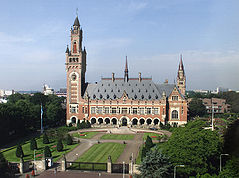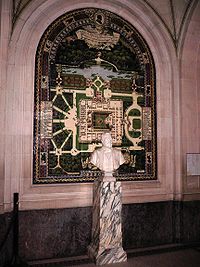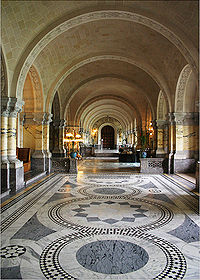
Peace Palace
Encyclopedia

The Hague
The Hague is the capital city of the province of South Holland in the Netherlands. With a population of 500,000 inhabitants , it is the third largest city of the Netherlands, after Amsterdam and Rotterdam...
, Netherlands
Netherlands
The Netherlands is a constituent country of the Kingdom of the Netherlands, located mainly in North-West Europe and with several islands in the Caribbean. Mainland Netherlands borders the North Sea to the north and west, Belgium to the south, and Germany to the east, and shares maritime borders...
. It is often called the seat of international law
International law
Public international law concerns the structure and conduct of sovereign states; analogous entities, such as the Holy See; and intergovernmental organizations. To a lesser degree, international law also may affect multinational corporations and individuals, an impact increasingly evolving beyond...
because it houses the International Court of Justice
International Court of Justice
The International Court of Justice is the primary judicial organ of the United Nations. It is based in the Peace Palace in The Hague, Netherlands...
(which is the principal judicial body of the United Nations
United Nations
The United Nations is an international organization whose stated aims are facilitating cooperation in international law, international security, economic development, social progress, human rights, and achievement of world peace...
), the Permanent Court of Arbitration
Permanent Court of Arbitration
The Permanent Court of Arbitration , is an international organization based in The Hague in the Netherlands.-History:The court was established in 1899 as one of the acts of the first Hague Peace Conference, which makes it the oldest institution for international dispute resolution.The creation of...
, the Hague Academy of International Law
Hague Academy of International Law
The Hague Academy of International Law is a center for high-level education in both public and private international law housed in the Peace Palace in The Hague, The Netherlands...
, and the extensive Peace Palace Library
Peace Palace Library
The Peace Palace Library is one of the oldest and most prestigious libraries specialized in international law. Its principal objective is to service the institutions that reside in the Peace Palace, including the International Court of Justice, the Permanent Court of Arbitration, and the Hague...
.
In addition to hosting these institutions, the Palace is also a regular venue for special events in international policy and law.
Conception

Friedrich Martens
Friedrich Fromhold Martens, or Friedrich Fromhold von Martens, also known as Fyodor Fyodorovich Martens in Russian and Frédéric Frommhold Martens in French was a diplomat and jurist in service of the Russian Empire who made important contributions to the science of international law...
and the US diplomat Andrew White
Andrew Dickson White
Andrew Dickson White was a U.S. diplomat, historian, and educator, who was the co-founder of Cornell University.-Family and personal life:...
, over providing a home for the Permanent Court of Arbitration
Permanent Court of Arbitration
The Permanent Court of Arbitration , is an international organization based in The Hague in the Netherlands.-History:The court was established in 1899 as one of the acts of the first Hague Peace Conference, which makes it the oldest institution for international dispute resolution.The creation of...
(PCA), which was established through the first Hague Peace Conference
Hague Conventions (1899 and 1907)
The Hague Conventions were two international treaties negotiated at international peace conferences at The Hague in the Netherlands: The First Hague Conference in 1899 and the Second Hague Conference in 1907...
in 1899. White contacted his friend the philanthropist Andrew Carnegie
Andrew Carnegie
Andrew Carnegie was a Scottish-American industrialist, businessman, and entrepreneur who led the enormous expansion of the American steel industry in the late 19th century...
about this idea. Carnegie had his reservations, and at first was only interested in donating money for the establishment of a Library of International Law. White however was able to convince Carnegie, and in 1903 Carnegie agreed to donate the US$1.5 million ($, adjusted for inflation) needed for a Peace Temple that would house the PCA as well as to endow it with a library of international law.
At first Carnegie simply wanted to donate the money directly to the Dutch
Netherlands
The Netherlands is a constituent country of the Kingdom of the Netherlands, located mainly in North-West Europe and with several islands in the Caribbean. Mainland Netherlands borders the North Sea to the north and west, Belgium to the south, and Germany to the east, and shares maritime borders...
Queen, Wilhelmina of the Netherlands
Wilhelmina of the Netherlands
Wilhelmina was Queen regnant of the Kingdom of the Netherlands from 1890 to 1948. She ruled the Netherlands for fifty-eight years, longer than any other Dutch monarch. Her reign saw World War I and World War II, the economic crisis of 1933, and the decline of the Netherlands as a major colonial...
for the building of the palace, but legal problems prohibited this, and in November 1903 the Carnegie Stichting was founded to manage the construction, ownership, and maintenance of the Palace. This foundation is still responsible for these issues at present.
Construction
To find a suitable design, the foundation called for an open international competitionArchitectural design competition
An architectural design competition is a special type of competition in which an organization or government body that plans to build a new building asks for architects to submit a proposed design for a building. The winning design is usually chosen by an independent panel of design professionals...
. The winning design, set in the Neo-Renaissance
Neo-Renaissance
Renaissance Revival is an all-encompassing designation that covers many 19th century architectural revival styles which were neither Grecian nor Gothic but which instead drew inspiration from a wide range of classicizing Italian modes...
style, was submitted by French
French people
The French are a nation that share a common French culture and speak the French language as a mother tongue. Historically, the French population are descended from peoples of Celtic, Latin and Germanic origin, and are today a mixture of several ethnic groups...
architect
Architect
An architect is a person trained in the planning, design and oversight of the construction of buildings. To practice architecture means to offer or render services in connection with the design and construction of a building, or group of buildings and the space within the site surrounding the...
Louis M. Cordonnier
Louis M. Cordonnier
Louis-Marie Cordonnier was a French architect, born in Haubourdin and associated principally with Lille and the French Flanders region.- Biography :...
. To build within budget, Cordonnier and his Dutch associate Van der Steur adjusted the design. The palace initially had two big bell towers in front and two small ones in the back. Only one big tower and one small tower remained in the final building. Also to save money, the separate library building from the winning design was incorporated into the Palace itself.
Thomas Hayton Mawson
Thomas Hayton Mawson
Thomas Hayton Mawson , better known as T. H. Mawson, was a British garden designer, landscape architect, and town planner....
designed the grounds. Because of the budget constraints, he also had to discard design elements—fountains and sculptures.
The Palace is filled with many gifts of the different nations who attended the Second Hague Conference as a sign of their support. Among the gifts are a 3.2 tonnes (3.1 LT) vase from Russia
Russia
Russia or , officially known as both Russia and the Russian Federation , is a country in northern Eurasia. It is a federal semi-presidential republic, comprising 83 federal subjects...
, doors from Belgium
Belgium
Belgium , officially the Kingdom of Belgium, is a federal state in Western Europe. It is a founding member of the European Union and hosts the EU's headquarters, and those of several other major international organisations such as NATO.Belgium is also a member of, or affiliated to, many...
, marble from Italy
Italy
Italy , officially the Italian Republic languages]] under the European Charter for Regional or Minority Languages. In each of these, Italy's official name is as follows:;;;;;;;;), is a unitary parliamentary republic in South-Central Europe. To the north it borders France, Switzerland, Austria and...
, a fountain from Denmark
Denmark
Denmark is a Scandinavian country in Northern Europe. The countries of Denmark and Greenland, as well as the Faroe Islands, constitute the Kingdom of Denmark . It is the southernmost of the Nordic countries, southwest of Sweden and south of Norway, and bordered to the south by Germany. Denmark...
, wall carpets from Japan
Japan
Japan is an island nation in East Asia. Located in the Pacific Ocean, it lies to the east of the Sea of Japan, China, North Korea, South Korea and Russia, stretching from the Sea of Okhotsk in the north to the East China Sea and Taiwan in the south...
, the clock for the clock tower from Switzerland
Switzerland
Switzerland name of one of the Swiss cantons. ; ; ; or ), in its full name the Swiss Confederation , is a federal republic consisting of 26 cantons, with Bern as the seat of the federal authorities. The country is situated in Western Europe,Or Central Europe depending on the definition....
, Persian rugs from Iran
Iran
Iran , officially the Islamic Republic of Iran , is a country in Southern and Western Asia. The name "Iran" has been in use natively since the Sassanian era and came into use internationally in 1935, before which the country was known to the Western world as Persia...
and wood from Indonesia
Indonesia
Indonesia , officially the Republic of Indonesia , is a country in Southeast Asia and Oceania. Indonesia is an archipelago comprising approximately 13,000 islands. It has 33 provinces with over 238 million people, and is the world's fourth most populous country. Indonesia is a republic, with an...
and the United States of America. The palace also features a number of statues, busts and portraits of prominent peace campaigners from around the world and of all eras.
In 1907 the first stone was symbolically placed during the Second Hague Conference. The construction began some months later and was completed with an inauguration ceremony on 28 August 1913, attended by, among others, Andrew Carnegie
Andrew Carnegie
Andrew Carnegie was a Scottish-American industrialist, businessman, and entrepreneur who led the enormous expansion of the American steel industry in the late 19th century...
.
In 1999 an eternal peace flame
Eternal flame
An eternal flame is a flame or torch that burns day and night for an indefinite period. The flame that burned constantly at Delphi was an archaic feature, "alien to the ordinary Greek temple"....
was installed in front of its gates.
In 2007, Queen Beatrix
Beatrix of the Netherlands
Beatrix is the Queen regnant of the Kingdom of the Netherlands comprising the Netherlands, Curaçao, Sint Maarten, and Aruba. She is the first daughter of Queen Juliana of the Netherlands and Prince Bernhard of Lippe-Biesterfeld. She studied law at Leiden University...
opened the new building for the Peace Palace Library of International Law, housing the entire catalogue of the library, a lecture hall and a new reading room in the bridge to the main building of the Peace Palace.
Occupants

- Permanent Court of ArbitrationPermanent Court of ArbitrationThe Permanent Court of Arbitration , is an international organization based in The Hague in the Netherlands.-History:The court was established in 1899 as one of the acts of the first Hague Peace Conference, which makes it the oldest institution for international dispute resolution.The creation of...
(since 1913) The original occupant for which the Peace Palace was constructed. From 1901 until the opening of the Palace in 1913, the Permanent Court of Arbitration was housed at Prinsengracht 71 in The HagueThe HagueThe Hague is the capital city of the province of South Holland in the Netherlands. With a population of 500,000 inhabitants , it is the third largest city of the Netherlands, after Amsterdam and Rotterdam...
. , it had 107 State Parties. - Peace Palace Library of International Law (since 1913). Being the original vision of Carnegie, the library grew quickly to house the best collection of international law. Although this stature is well in the past, the library still contains some original classical works, as the original copies of Hugo GrotiusHugo GrotiusHugo Grotius , also known as Huig de Groot, Hugo Grocio or Hugo de Groot, was a jurist in the Dutch Republic. With Francisco de Vitoria and Alberico Gentili he laid the foundations for international law, based on natural law...
' works on peace and law and Erasmus' Querela Pacis. - The Hague Academy of International LawHague Academy of International LawThe Hague Academy of International Law is a center for high-level education in both public and private international law housed in the Peace Palace in The Hague, The Netherlands...
(since 1923). Established in 1914, strongly advocated by Tobias AsserTobias Michael Carel AsserTobias Michael Carel Asser was a Dutch lawyer and legal scholar of Jewish background, cowinner of the Nobel Prize for Peace in 1911 for his role in the formation of the Permanent Court of Arbitration at the first Hague peace conference...
. Funds for the Academy came from another peace project by Andrew Carnegie, namely the Carnegie Endowment for International PeaceCarnegie Endowment for International PeaceThe Carnegie Endowment for International Peace is a foreign-policy think tank based in Washington, D.C. The organization describes itself as being dedicated to advancing cooperation between nations and promoting active international engagement by the United States...
, established in 1910. - The Carnegie Stichting (since 1913).
- Permanent Court of International JusticePermanent Court of International JusticeThe Permanent Court of International Justice, often called the World Court, was an international court attached to the League of Nations. Created in 1922 , the Court was initially met with a good reaction from states and academics alike, with many cases submitted to it for its first decade of...
(1922–1946). In 1922 the Permanent Court of International Justice of the League of NationsLeague of NationsThe League of Nations was an intergovernmental organization founded as a result of the Paris Peace Conference that ended the First World War. It was the first permanent international organization whose principal mission was to maintain world peace...
was added to the occupants. This meant the Library was forced to move to an annex building, and the Permanent Court of Arbitration was moved to the front left of the building. This Court was followed by the; - International Court of JusticeInternational Court of JusticeThe International Court of Justice is the primary judicial organ of the United Nations. It is based in the Peace Palace in The Hague, Netherlands...
(since 1946). In 1946, with the birth of the United NationsUnited NationsThe United Nations is an international organization whose stated aims are facilitating cooperation in international law, international security, economic development, social progress, human rights, and achievement of world peace...
, the International Court of Justice was established as her principal judicial organ.
The Permanent Court of Arbitration and International Court of Justice work separately, although they do use the same 'pool' of international judges. The other international courts in The Hague, the Iran-United States Claims Tribunal
Iran-United States Claims Tribunal
The Iran-United States Claims Tribunal is an international arbitral tribunal established out of an agreement between Iran and the United States, under an understanding known as the Algiers Accords of January 19, 1981. The Algiers Accords were the outcome of negotiations between Iran and the United...
, the International Criminal Tribunal for the former Yugoslavia
International Criminal Tribunal for the former Yugoslavia
The International Tribunal for the Prosecution of Persons Responsible for Serious Violations of International Humanitarian Law Committed in the Territory of the Former Yugoslavia since 1991, more commonly referred to as the International Criminal Tribunal for the former Yugoslavia or ICTY, is a...
and the International Criminal Court
International Criminal Court
The International Criminal Court is a permanent tribunal to prosecute individuals for genocide, crimes against humanity, war crimes, and the crime of aggression .It came into being on 1 July 2002—the date its founding treaty, the Rome Statute of the...
are separate organizations, located elsewhere in The Hague.

